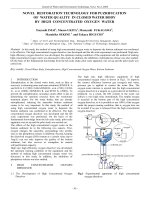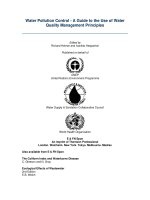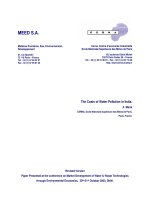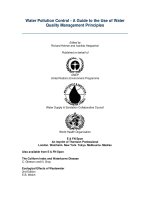The Importance of Water and Water Quality in Brewing pptx
Bạn đang xem bản rút gọn của tài liệu. Xem và tải ngay bản đầy đủ của tài liệu tại đây (783.3 KB, 24 trang )
The Importance of Water and
Water Quality in Brewing
SAAFost 8 July 2011
Drs Frieda M Dehrmann and Anna Cameron – Clarke
Central Office QA Manager & Technical Consultant
SAB Ltd, 65 Park Lane, Sandown, Johannesburg
You can't have a Real Country unless you
have a BEER and an airline - it helps if
you have some kind of a football team,
or some nuclear weapons, but at the
very least you need a BEER.
• Frank Zappa
“In wine there is wisdom, in beer
there is strength, in water there is
bacteria.”
David Auerbach (2002)
This quote belies some real chemistry which has allowed brewers to
successfully create safe drinking experiences, and enjoy unique beer
styles. Over the years, water sources have been an important
determinant for where breweries have been located. The notion of best
ales in the Empire from Burton on Trent, and the clearest pale lagers from
Pilsen is inextricably linked to the chemistry of the water.
• Water in Brewing
• Water as an ingredient
– Brewhouse Chemistry
– Water and Taints
– Water and Micro-organisms
• Water as a process facilitator
• Our Systems
Contents
Outline of SABMiller and SAB Ltd
• The South African Breweries Limited was founded in 1895
• The company became SABMiller plc in 2002 when it
purchased the Miller Brewing Company in the US
• SABMiller is listed in London and Johannesburg
• SABMiller is the world’s second largest brewer by volume
• The company has interests in more than 60 countries on
four continents, and produces more than 150 brands.
• SAB Ltd is the South African operation of SABMiller plc and
currently produces 25.9-million hectolitres of beer per
annum and 14-million hl of other beverages through its soft
drinks division, ABI. Including Bavaria, SABMiller produces
187-million hectolitres of beverages a year, of which 143-
million are beer.
SAB Ltd’s Breweries
Water in Brewing
Water is essential in brewing as an ingredient and as a process
facilitator.
Ingredient:
• Beer is composed of 90 – 95% water (typically)
• Water is the main ingredient and is added to the malt to create
the mash in the brewhouse process
• Some brewers who brew at high gravity may add water back at
filtration
Process facilitator:
• Water is an essential component for cleaning and rinsing and in
various production processes such as pasteurisation, steam
generation and CO2 management
The composition and quality of the water is vitally important
for:
– Brewhouse chemistry
– Anti-taint assurance
– Microbiological impact
Brewhouse Process
2.2 Mashing2.1 Milling 2.3 Lautering
2.6 Wort Cooling
2.5 Whirlpool
2.4 Boiling
Solid adjuncts
water
2.7 High Gravity
9
Filtration process
5. Filtration 6.1 BBT/PR
CO2
7. Packaging
water
Brewhouse Chemistry
In the brewhouse, the main objectives are:
a) Create a simple sugar mix for the yeast
to use to create alcohol
• The role of water and minerals is critically
important at this point
• pH
• Hardness/alkalinity
b) Sterilise the wort
Brewhouse Chemistry
Calcium
The calcium ion is by far the most influential mineral in the brewing process.
Calcium reacts with phosphates, forming precipitates that involve the release of
hydrogen ions and in turn lowering the pH of the mash. This lowering of the pH
is critical in that it provides an environment for alpha-amylase, beta-amylase,
and proteolytic enzymes
Magnesium
Magnesium ions react similarly to calcium ions, but since magnesium salts are
much more soluble, the effect on wort pH is not as great. Magnesium is most
important for its benefit to yeast metabolism during fermentation. Magnesium
carbonate reportedly gives a more astringent bitterness than does calcium
carbonate
Sodium
Sodium has no chemical effect; it contributes to the perceived flavor of beer by
enhancing its sweetness. Levels from 75 to 150 ppm give a round smoothness
and accentuate sweetness, which is most pleasant when paired with chloride
ions than when associated with sulfate ions. In the presence of sulfate, sodium
creates an unpleasant harshness, so the rule of thumb is that the more sulfate
in the water, the less sodium there should be (and vice versa)
Potassium
Like sodium, potassium can create a "salty" flavor effect. It is required for yeast
growth and inhibits certain mash enzymes at concentrations above 10 mg/l.
Sulphates
Sulfates positively affects protein and starch degradation, which favors mash
filtration and trub sedimentation. However, its use may result in poor hop
utilization (bitterness will not easily be extracted) if the levels are too high. It
can lend a dry, crisp palate to the finished beer; but if used in excess, the
finished beer will have a harsh, salty, and laxative character.
During mashing, the presence of minerals is critically important for a
number of reasons:
Brewhouse Chemistry
Phosphates
Phosphates are important pH buffers in brewing and useful for reducing the pH in
mashing and during the hop-boil
Chlorides
Calcium and magnesium chlorides give body, palate fullness, and soft-sweet
flavor to beer. The certain roundness on the palate given by sodium chloride
(common table salt) makes this salt eminently suited for all types of sweet beers –
for both dark beers and stouts.
Carbonates
The presence of carbonate ions and their effect in raising pH can result in less
fermentable worts (a higher dextrin/maltose ratio), unacceptable wort color
values, difficulties in wort filtration, and less efficient separation of protein and
protein-tannin elements during the hot and cold breaks.
Nitrates and
Nitrites
Nitrate, in and of itself, is not a problem; it has no effect on beer flavor or brewing
reactions. However, high nitrite levels may reduce the fermentation rate, dampen
the rate of pH reduction, and give rise to higher levels of vicinal diketones
Iron
Iron in large amounts can give a metallic taste to beer. Iron salts have a negative
action at concentrations above 0.2 mg/l during wort production, preventing
complete saccharification, resulting in hazy worts, and hampering yeast activity.
Radically promote staling through Iron based hydroxy radicl formation.
Copper
Copper, in concentrations as low as 0.1 mg/l can act as catalysts of oxidants thus
leading to irreversible beer haze. At levels more than 10 mg/l, copper is toxic to
yeast
Zinc
Zinc plays an important role in fermentation and has a positive action on protein
synthesis and yeast growth. It also impacts flocculation and stabilizes foam
(promotes lacing)
Manganese
Manganese is important for proper enzyme action and has a positive action on
protein solubilization and yeast
Brewhouse Chemistry
pH in the Brewhouse:
• pH in mashing is critical or the activity of various enzymes in mashing
(alpha & bet amylase, and proteolytic enzymes).
• pH in lautering is important as raised pH allows the extraction of the
neutral tannins which contribute t harsh and astringent flavours.
• pH of the boil is critical to form a good hot break. Ideally pH of 5.0 – 5.5
should be held to encourage the precipitation of protein.
Brewhouse Chemistry - hardness
Total water hardness is the measure of the salts present, the most
common being bicarbonate, calcium, and magnesium ions present in the
water. Total hardness is expressed as mg/l of calcium carbonate (CaCO3).
Generally,
• < 50 mg/l is considered very soft water,
• 50 to 100 mg/l is considered soft water,
• 100 to 200 mg/l is considered medium-soft water,
• 200 to 400 mg/l is considered moderately hard water,
• 400 to 600 mg/l is considered hard water, and
• > 600 mg/l is considered very hard water.
Temporary Hardness
This hardness is due to carbonates and bicarbonates of magnesium and
calcium and can be removed by high temperatures as CO
2
boils off.
↑alkalinity, ↑pH.
Permanent Hardness
Permanent hardness is that portion of total hardness remaining after the
water has been boiled. Permanent hardness results from calcium and
magnesium salts of sulfates and chlorides remaining in the water.
Brewhouse Chemistry
Alkalinity in the Brewhouse:
Alkalinity is a measure of the buffering capacity of the bicarbonate ions
and, to some extent, the carbonate and hydroxide ions of water. These
three ions all react with hydrogen ions to reduce acidity and raise pH.
Expressed as mg/l as calcium carbonate (CaCO3) for all three ions.
Residual Alkalinity
This is related to permanent hardness and is also determined by the
removal of bicarbonates.
Alkalinity is important because of its impact on pH, and because of the
contribution to mineral composition.
Where are these parameters managed?
Water balancing is done prior to mashing to ensure the correct conditions
for enzymatic function and correct extraction of malt components such as
polyphenols.
Alkalinity (and temporary hardness) is typically reduced by addition of
calcium sulphate.
Brewhouse Chemistry
How does this impact on the beer product:
High pH, and high alkalinity water (permanently hard) results in extraction
of tannins and astringent flavours
Lower pH high alkalinity water (typically non carbonate) results in crisp full
bodied beers such as the Ales.
Water with elevated hardness is good for brewing dark beers, such as
extra strong bitters, stouts, and ales. This is because the dark roasted
malts lower the pH of hard water, and facilitate the reduction of the
alkalinity and pH.
Soft water is better for pale lagers with good hop character. If they are
brewed in hard water, they end up being very hard and astringent.
This has been learned over the years, with brewers who brew dark beers
being situated near hard water sources, and pale lagers close to soft
water sources. Typically the waters of Dublin are hard, those of Burton on
Trent are high in calcium sulphate, and those of Pilsen (the home of clear
lagers – are soft waters.
Water and Taint
Water is a common source of Taints in beer
Typically, water is the source of the majority of taints associated in beer:
a) Chlorine – which in organic media is mostly converted to substituted
chlorophenols such as tri-chlorophenols (TCP, medicinal taints)
b) Salty – certain waters are raised in sodium (boreholes close to the
sea). Typically, [Na] > 50 ppm are perceived as salty
c) Metallic – water raised in iron tastes “rusted” and “bloody”. Typically
[Fe
2+
] > 0.05 ppm are perceived organoleptically
d) Trihalomethanes – occasionally in some treated waters. These can
also lend a musty odour and taint.
Water and Micro-organisms
Water is a source of a number of micro-organisms:
• Pseudomonas spp
• Coliforms
• Yeasts and Fungi
The majority of micro-organisms cannot survive the harsh environment of
beer (low pH, raised alcohol, and hop alpha acids).
Boiling of water in the brewing process, and the wort boiling typically
sterilises the water or wort.
Our systems to manage
In most breweries, water is managed as follows:
1. Water Hygiene and taint management
2. Water treatment for suitability at point of us
Our systems to manage
In most breweries, water is managed as follows:
a) Quality assurance monitoring of incoming water, through SPP
relationships with the supply municipality (monitoring of THMs, micro-
organisms, salts, ions).
b) Quality control of pH, hardness, chlorine and micro organisms of
incoming water – conducted by our laboratories.
c) Chlorination of incoming water to remove any residual micro-
organisms. Water is held in treatment reservoirs.
d) De-chlorination of water through activated carbon filters.
• This step is followed by a QC check for chlorine.
• Annual QC also includes the checks for absorption and carbon activity.
• Daily taste checks for chlorine and other taints (metallic and THMs)
e) Quality assurance and due diligence (annual) pesticides, herbicides,
metals, and other compounds, external 3
rd
party lab
Our systems to manage
In most breweries, water is managed as follows:
a) Boiling of water to remove temporary hardness
b) Acidification of mash water (lactic acid)
c) Addition of brewing salts to increase softness (addition of calcium
chloride, or calcium sulphate)
Water as a process facilitator
Water is used to facilitate the following activities:
a) Steam generation
b) CIP and rinsing of tanks and vessels
c) Bottle washing
d) Pasteurisation
None of these actvities are considered product contact activities. However,
there are a number of processes that are in place to manage water
quality and suitability, such as:
a) Water softening for boiler water
b) Addition of acids and alkalines to the CIP process
c) Heat to bottle washer water
d) Treatment of pasteuriser water with sterilising agents.
Water quality is generally monitored by the Utilities operators for point of
use suitability.
The Sustainable Use of Water
• Extreme targets for water usage
• Reduction of use of water at all non product related water
– Re-use of water such as pasteuriser water, through treatment
• Certain breweries in India have pioneered the use of treated
water through to agricultural land adjoining the brewery
• Ibhayi brewery – Project Eden – for fish farming and
hydroponic vegetable famrs
Thank you
• Any questions?









